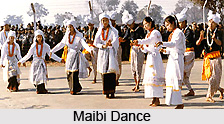 Maibi dance is an Indian spiritual dance which deals with the cosmogony of the Meitei people of Manipur. The dance is performed during the celebration of festival Lai-Haraoba. This is an annual ritual festival of the Meitei Manipuris. The Maibis are the priestesses considered as spiritual mediums by the local people. This feeling can be traced through their dances and the whole concept of cosmogony of the Meitei people and their way of life.
Maibi dance is an Indian spiritual dance which deals with the cosmogony of the Meitei people of Manipur. The dance is performed during the celebration of festival Lai-Haraoba. This is an annual ritual festival of the Meitei Manipuris. The Maibis are the priestesses considered as spiritual mediums by the local people. This feeling can be traced through their dances and the whole concept of cosmogony of the Meitei people and their way of life.
Interestingly, anyone cannot be a maibi. To be a maibi, one has to show definite signs of being spiritually predisposed. The concerned person may show some signs of spiritual predisposition at an early age or when she is an adult. Once her spiritual power is proved, she is selected to be a maibi. From then onwards she leads the rest of her life as a maibi is supposed to.
Customs Related to Maibi Dance
The Maibi people of Manipur perform such items on ceremonies for the God or on festivals at the bank of a river. They summon the spirits of the Gods in an earthen pot and later tie nine and seven threads for God and Goddesses, after which the dance begins.
The beginning of the dance, describes the entire process of the creation of the construction of houses, temples and the various occupations of the people adopted to sustain them with time. In short, it is a kind of re-living of the way of life of the past. At a time of the dance, the Maibis hold the leaves of sacred plant called Langthrei between their fingers.
Performance of Maibi Dance
The performance of this spiritual dance comprises of slow, controlled and lyrical movements. The dance starts from the kneeling position. The dancer then rises at a slow pace. In the next step, she holds both her hands near her navel with both thumbs and forefingers touching each other. While performing, the dancer also holds a leaf of a sacred plant quite skilfully between the forefinger and middle finger. Right from the beginning of the dance, the dancer is in trance. Through the performance of Maibi, the dancers invoke the deities and urge them to sanctify the entire community.



















